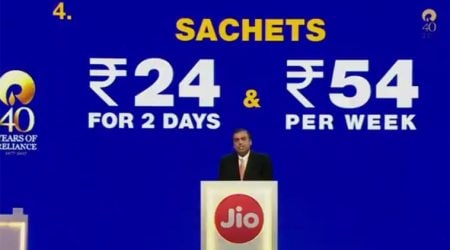 Reliance Jio JioPhone 4G VoLTE feature phone: The crucial bit about the phone will be how it brings down the barriers for data and device affordability. The phone will be technically free, though buyers will need to pay a Rs 1,500 refundable security deposit to “prevent misuse”.
Reliance Jio JioPhone 4G VoLTE feature phone: The crucial bit about the phone will be how it brings down the barriers for data and device affordability. The phone will be technically free, though buyers will need to pay a Rs 1,500 refundable security deposit to “prevent misuse”.
The much-awaited 4G VoLTE feature phone from Reliance Jio is here. However, RIL chairman Mukesh Ambani chose to dub JioPhone ‘India ka Smartphone’ because it comes with features like 4G data, a TV cable link and apps that are usually unheard of in feature phones. Ambani said the phone has been envisioned and created by young Indian engineers and will be fully made in India by end of the years. Ambani has set his team a target of supplying 5 million devices a week from September and by end of the year production will shift to India.
But the crucial bit about the phone will be how it brings down the barriers for data and device affordability. The phone will be technically free, though buyers will need to pay a Rs 1,500 refundable security deposit to “prevent misuse”. At the end of three years, they will be able to given the phone back and reclaim the security deposit.
With the JioPhone, Jio will also try and bring down data affordability to a large extent. The monthly tariff of Rs 153 will give customers access to free voice calls and unlimited data. There will be easier to buy sachets priced at Rs 24 and Rs 54, but this will mean a larger monthly cost to the user. Users who want to consume more data will need to opt for the Rs 309 Dhan Dhana Dhan plan.
What JioPhone really brings to the table is a larger screen that makes it easier for users to consume video. Since JioMovie and other such apps will be preloaded, the phone could trigger a spurt in video consumption in a segment which had no access to this type of content so far.
The opportunity for Jio is clearly this. Otherwise it would be hard to get the 50-crore odd feature phone users to move, just on the temptation of being on a faster 4G network. Yes, the voice-heavy users might find the appeal of a flat rate for unlimited calls tempting, but Jio would certainly like them to think beyond this given they have now have access to ‘unlimited data’. But the ‘unlimited data’ on the Rs 153 plan comes with a fair usage policy (FUP) for 500MB a day and, as Ambani said, those who which to beam video from the apps to their televisions should get on the costlier Rs 309 plan, which has a 1GB daily limit — that could be about four hours of video.
While consumers will gain from the new device and tariff packs, the JioPhone is not good news for service providers and other manufacturers. The service providers will need to come up with more compelling plans to keep their customers, at least those who are not really keen on the video bit. This would mean free calls and at least some data at rates less that Rs 153 a month. But then most of these providers are on 2G, and Jio is 4G only, which most users will view as a bump up even though they might not use the data.
The JioPhone is reportedly manufactured by Intex, but Jio will be the vendor. No other 4G VoLTE capable feature phone will be able to work on the Rs 153 plan that Jio is offering. Anyway, for any other feature phone manufacturer to remain relevant the phone will have to be cheaper than Rs 1,500, offer at least some access to video and a colour screen and be 4G compatible. As per IDC data, 136 million feature phones were shipped last year.
At the moment, there are 2G feature phones with colour screen from obscure brands at around Rs 800, but they won’t work on 4G and can’t offer a decent data experience. Lava launched a 4G feature phone a few months back, but that cost Rs 3,333. So to make a 4G feature phone relevant in the JioPhone world, someone will have to subsidise — either the service provider or the manufacturer. If Jio is able to offer a better device experience and stable data to sustain it, then we could be looking at a virtual monopoly over the feature phone market in a few months.

